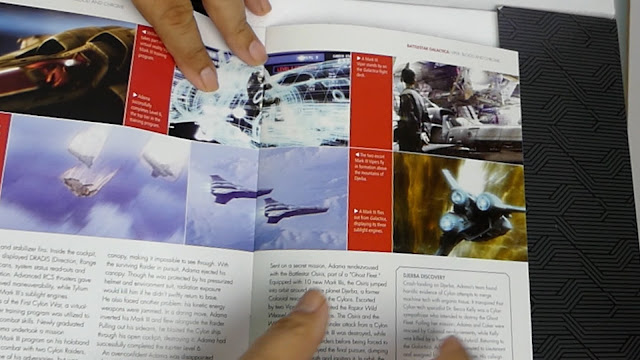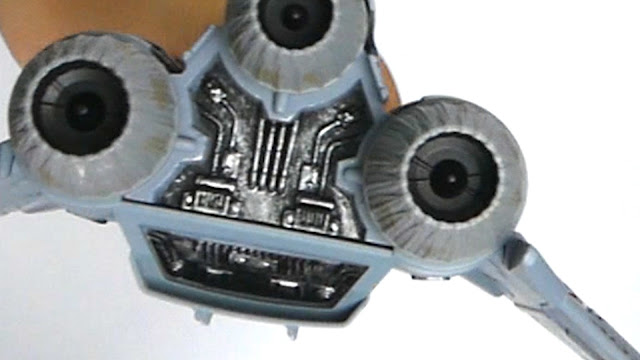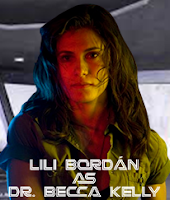Today, we are looking at the first Viper Admiral, then Ensign Adama's, which was first assigned, the Viper Mark lll.
EAGLEMOSS BATTLESTAR GALACTICA: BLOOD & CHROME VIPER MARK lll REVIEW
As usual, the Eaglemoss Hero Collection comes in these attractive boxes.
All Battlestar Galactica Hero Collection models come with booklets that give images, history, and production insight into the series ship.
The Viper is packed in and surrounded by stylophones cut into the Viper and shape cutouts.
So far, my Viper Mark looks to be in good condition.
When I bought this model from Amazon, it was listed as having product dimensions of 13" x 9.5" x 5.25" inches, and the Viper is supposed to weigh 1.82 pounds, almost 2 pounds. But as I have learned, those measurements aren't entirely accurate. So, I measured.

Width 6 1/2" 16.51 cm
Height 5 1/2" 13.97 cm
We have about ten and a quarter inches long for the length, which is about a little over 26 centimeters. And a height of about five and a half inches, which in metric is just a bit under 14 centimeters, and a width of six and half inches, otherwise known as sixteen points fifty-one centimeters.
L 10 1/4" 26.035 cm
H 5 1/2" 13.97 cm
W 6 1/2" 16.51 cm
I like the detail of the inset portions of the Viper's fuselage. The engine detailing is rather nice, too.
The weathering is phenomenal. The color scheme, with its grey tone, really allows the battle stripes to stand out. The Mark ll should have survived until after the war, but as in real life F-35. Just a thought.
Nice rear detailing. Similar to the original series but with more stylized engine exhaust ports.
My only peeve is that there is not a Viper jock in the cockpit. That would have been a nice detail, but hey!
The War was over. The Cylons lost. The ones, the fours, the fives, and their cadre of centurions stationed in the Colony were gone. Demolished by a nuke fired by dead colonial raptor pilots just as the Galactica escaped.
After finding themselves orbiting a pretty blue planet with giant oceans, green savannas, majestic mountains, and plenty of drinkable water with the correct amount of oxygen, nitrogen blends to support human life. The planet orbited the sun at just the right place in the system to have the proper temperature range to support human life.
The fleet rendezvousing with the Galactica makes plans to abandon technology and essentially burn their boats like Cortez's men when they landed in the new world.
There is no going back.
Admiral William Adama, who's been fighting Cylons most of his life. He took his last flight off Battlestar Galactica for the very last time, the first Battlestar he was assigned to many years ago.
Looking back at his career, we know that for some of that time as a Viper pilot in the first Cylon War, he flew the Viper Mark ll,
But did you know that he also flew the Viper Mark lll?
The Colonial Fleet relied on the Viper series, and the Mark III was the third generation of these fighters.
See my videos on the Vipers Mark l and ll.
A single-pilot, multi-role attack spacecraft, the third-generation Viper, was introduced near the conclusion of the First Cylon War as a replacement for the legendary Mark II.
The design of this aircraft served as an inspiration for later
versions of the multi-role Vipers, developed years after the Armistice and culminated in the highly sophisticated Mark VII.The Mark III was meant to succeed the Mark II, but it was plagued by severe financial and material constraints throughout the War and the fighter's astronomical price tag. Therefore, the Mark III did not completely replace the Mark II by the Armistice due to its low use and small numbers.
By Operation Raptor Talon, Battlestars like Galactica had switched back to Mark IIs, while Mark IIIs played an essential role in missions like the Ghost Fleet attack. It is improbable that any Mark IIIs were operational during the Twelve Colonies' Fall since they were all decommissioned after the War.
Let's talk about context. When Battlestar Galactica's run was over, several ideas for more Battlestar content were floated on the SyFy channel.
At the time, Caprica was one of the potential shows the SyFy channel worked on for the Battlestar Galactica franchise.
This one was titled Battlestar Galactica: Blood & Chrome, a precursor to the revamped Battlestar Galactica series. The web series evolved into a pilot for a potential television show that would have followed young William Adama's early adventures, but the project was canceled. The main actors are Ben Cotton, Lili Bordán, and Luke Pasqualino as the young gung-ho ensign Adama. Michael Taylor penned the teleplay based on his story, along with David Eick, Bradley Thompson, David Weddle, and Jonas Pate, who directed the film.
Blood & Chrome was first released on November 9, 2012, as a 10-episode web series associated with Machinima.com. However, Caprica was released by the SyFy channel in 2010. That show was set fifty-eight years before the events of the main series; Caprica depicted the creation of the Cylon androids by humans, which would eventually turn against them.
As referenced many times during Battlestar Galactica's run, Bill Adama's father and Lee's grandfather, Joseph Adama, was a lawyer. Who, apparently, Romo Lampkin claimed to have known is a featured central character in Caprica. Daniel Graystone, who developed the Cylons, was also featured in the show. Caprica, unfortunately, was canceled after only one season.
Blood and Chrome was broadcast on February 10, 2013, as a television movie on Syfy. Unfortunately, probably due to many already seeing the web series a few months earlier in 2012, they didn't bother showing up to watch it on SyFy. February 10 was a Sunday, and at that time, The Walking Dead was crushing all other Sunday shows.
I would be remiss if I didn't briefly summarize Blood and Chrome. I would have been ecstatic if they had at least gotten one or two seasons of stories about a young Bill Adama.
The story opens with a young William explaining why he joined the military in a letter he wrote to his father, Joseph.
We see the young pilot fighting the old-style Cylon Raiders. You know, the ones with the three Cylon Centurions required to fly them.But alas, it is all a training simulation. It is the tenth year of the First Cylon War, and Ensign William Adama arrives on a shuttle to a less battle-scarred Battlestar Galactica with all its battle armor intact.
Acting all cocky due to his exploits in the simulation but with no real experience, he is quickly assigned to pilot a Raptor named "Wild Weasel."
He also meets Coker Fasjovik. Coker is ready to go home. His second mandatory tour is almost complete, and he wants to go home to see his wife and kid.
We also meet Galactica's CO, Commander Nash. He quickly assigns the two to make a simple supply run.
It is a four-day mission, and Adama is to avoid the enemy altogether.
Instead of supplies, Adama and Coker discover that Dr. Beka Kelly, a software developer, is aboard their ship.
The chemistry was obvious when Adama met her in the showers. But when he learned that she had worked for Graystone Industries before, his emotions quickly subsided.
The young Bill is unhappy about her line of work, considering she is one of the developers on the CPU upgrade project that brought the Cylons to full artificial intelligence.
Kelly, more or less, takes over the mission from Bill and Coker. Oh yeah, Coker is now calling Bill Husker.
They have been ordered to keep radio silence the entire way to the Battlestar Acheron's meeting point, close to the front lines.
Unfortunately, an ambush had already destroyed the Acheron when they arrived. Then, Bill starts making evasive maneuvers as three Cylon Raiders approach them. Kelly instructs them to transmit on an open frequency after dodging the enemy and informs them they cannot return to Galactica.
To enter Cylon space, they are provided with a set of coordinates. After a furious dispute, Coker agrees to comply with Adama and Kelly's demands, and the three set out.
While in flight, Kelly tells Adama she was married to the war hero Ezra Barzel, who encouraged many young people to enroll in the academy. They discover a field of asteroids concealing a string of Colonial "ghost ships"—ships that were believed lost—when they arrive at the coordinates.
Dr. Kelly meets with the Commander on board the Osiris, an Orion-class Battlestar, and they receive a mission briefing. Kelly is to be taken to the planet Djerba, located deep within Cylon territory, for an important assignment, and the fleet is on its way there.
Since they've gone this far together, Adama is adamant that the doctor be permitted to fly in with her. Surprisingly, a Cylon base star materializes upon their arrival on the planet. The Commander decides against aborting and orders a full launch, instructing Adama and his escorts to head for the surface.
As the Osiris were about to launch Adama's Raptor with a Viper escort, a Cylon Basestar appeared on Dradis.
The Osiris and her crew attempted to draw fire away from the landing party. She ended up having to ram the Basestar and detonate their nuclear warheads manually.
A fierce air battle erupted, with the Vipers and the Raptor engaging in a deadly dance with several Cylon Raiders. The space around them was a chaotic symphony of laser fire and explosive bursts.
The battle looked phenomenal. The old Cylon Raider never looked better than in this dogfight.

This is during the Cylon War when the Raptor comes equipped with a tail gun, and Coker takes on the gunner role.
Following a crash landing, the trio embarks on a suspenseful journey towards a beacon from a Marine tactical team.
What is Kelly's secretive mission? Her hidden motives add a layer of mystery to the plot, keeping the audience guessing.
They find the remains of the Marine team in a cave on this snow-covered Hoth-like planet. Apparently, biomechanical snake-like creatures killed the Marines. The only survivor, Tech Seargent Toth. A bomb ordnance specialist. He saves the trio and takes them off to a ski resort.
Yep, Djerba was a high-end ski resort planet. Taken over by the Cylons at the beginning of the War and supposedly abandoned by them, but there is a listening post. Which is our traveler's primary objective.
After a romantic interlude between Adama and Kelly, the Cylons attack, and there is some pretty cool hand-to-hand combat between humans and Cylons.
There is one peculiar thing. A strange-looking Cylon finds Kelly, but after scanning her dog tag, he leaves her alone. Coker takes out the Cylon. After the usual tension between Coker Adama and Kelly, they take off for the communication tower.
If you have not seen Blood and Chrome, I don't want to spoil the rest.
I liked the ending and wish there had been more episodes.
Having multiple Vipers in my collection reminds me of when I was in my early teens and wanted to be a film director.
My wife suggested that I display my BSG Viper and Cylon Raider models and hang them on the ceiling. (That way, it is out of her way.) I explained to her that it puts them too far away to enjoy, and all you see is the fighters' bottoms.
I know because that was my bedroom when I was 14 years old.
But, if you, like me, are a fan of Battlestar Galactica and enjoyed this video, I invite you to hit the like button, subscribe to this blog if you haven't, and share your thoughts on the Eaglemoss Collection or say hi in the comments. Your engagement is what keeps this community alive.
















































